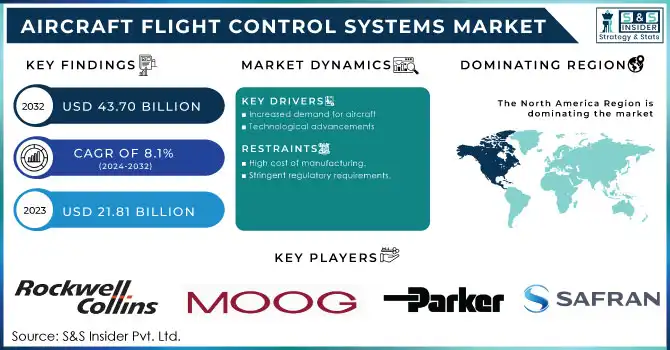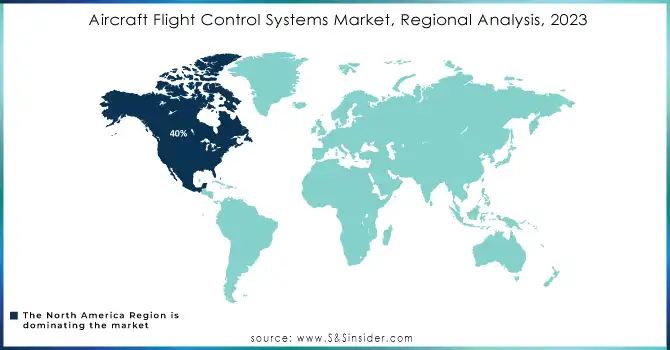Aircraft Flight Control Systems Market Report Scope & Overview:
The Aircraft Flight Control Systems Market size was USD 21.81 billion in 2023 and is expected to reach USD 43.70 billion by 2032, growing at a CAGR of 8.1% over the forecast period of 2024–2032.

To get more information on Aircraft Flight Control Systems Market - Request Free Sample Report
Aerodynamic devices that combine automation and electromechanical expertise are called aircraft flight control systems (FCS). Primary FCS and secondary FCS make up these systems. These are employed to improve aircraft performance and ensure safety during banking, pitching, and rolling. While wing flaps, spoilers, elevators and ailerons are examples of primary FCS, trim systems, leading-edge devices, and wing flaps are examples of secondary FCS.
The need for aircraft is rising due to the expansion of air travel, the growing usage of aircraft in military applications, and the rapid improvement of technology, which is driving the global market for aircraft flight control systems. The market's growth is, however, constrained by the increased cost of production and the integration of FCS on aircraft. The short lifespan of FCS is yet another element impeding market expansion. Additionally, it is anticipated that ongoing research and development efforts to lighten FCS's weight and rising consumer demand for lightweight FCS will accelerate market expansion.
The Aircraft Flight Control Systems market has seen advancements in technology, including improved targeting systems, stabilization, automation, and connectivity. These advancements enhance accuracy, reduce crew workload, and improve overall system effectiveness.
The market for aircraft FCS is divided into segments based on type, application, technology, and geographic location. Regional jets, large-body aircraft, and narrow-body aircraft are among the types examined in this study. The market is divided into business aviation, military aviation, commercial aviation, and other categories based on application. It is divided into mechanical, fly-by-wire, and hydro-mechanical FCS categories according on technology.
The demand for Aircraft Flight Control Systems varies by region. Countries with larger defense budgets, such as Russia, the United States, China, and major European nations, are significant markets for Aircraft Flight Control Systems. Additionally, emerging economies are investing in defense modernization programs, contributing to market growth.
MARKET DYNAMICS
DRIVERS:
-
Increased demand for aircraft
-
Technological advancements
There has been a significant amount of technological advancement in FCS in recent years, with the development of fly-by-wire systems, digital flight control systems, and other advanced technologies. These advancements are making FCS more efficient, reliable, and cost-effective.
RESTRAIN:
-
High cost of manufacturing.
-
Stringent regulatory requirements.
FCSs are subject to stringent regulatory requirements, which can make it difficult for companies to bring new products to market.
OPPORTUNITY:
-
Development of new aircraft.
-
Emerging markets.
Emerging markets are a major growth opportunity for the FCS market. These markets are experiencing rapid growth in air travel demand, and they are increasingly adopting advanced FCS technologies.
CHALLENGES:
-
Cybersecurity threats.
-
Supply chain disruptions.
Supply chain disruptions can significantly impact the FCS market, as they can lead to component shortages and production delays.
IMPACT OF RUSSIA-UKRAINE WAR
The sanctions that have been imposed on Russia by the United States, the European Union, and other countries have made it difficult for Russian companies to obtain essential components for FCS. This has led to shortages of these components and has disrupted the production of FCS in Russia. The war has also disrupted the global supply chain for FCS components. This is because many of the components for FCS are manufactured in Ukraine and Russia.
The war has made it difficult or impossible to transport these components to other countries, which has led to shortages of these components and has disrupted the production of FCS around the world. The value of the global FCS market is expected to decline by 5% in 2023 due to the war. The number of FCS units shipped is expected to decline by 10% in 2023 due to the war. The average selling price of FCS is expected to decline by 2% in 2023 due to the war. These figures are based on estimates from industry analysts. The actual impact of the war on the FCS market may be greater or lesser than these estimates.
IMPACT OF ONGOING RECESSION
The recession is expected to lead to a reduction in demand for FCS. This is because airlines are likely to reduce their flight schedules and cancel orders for new aircraft. This demand reduction will put pressure on FCS manufacturers to reduce prices, which will erode their margins. The recession is also expected to lead to increased costs for FCS manufacturers. This is because the cost of raw materials, transportation, and labor is expected to rise. These increased costs will further erode the margins of FCS manufacturers.
The value of the global FCS market is expected to decline by 3% in 2023 due to the recession. The number of FCS units shipped is expected to decline by 7% in 2023 due to the recession. The average selling price of FCS is expected to decline by 1% in 2023 due to the recession. These figures are based on estimates from industry analysts. The actual impact of the recession on the FCS market may be greater or lesser than these estimates.
KEY MARKET SEGMENTATION
By Aircraft Type
-
Narrow Body Aircraft
-
Wide Body Aircraft
-
Regional Jets
By Application
-
Commercial Aviation
-
Business Aviation
-
Military Aviation
By Technology
-
Hydro-mechanical FCS
-
Mechanical FCS
-
Fly-by-wire FCS
REGIONAL COVERAGE:
North America
-
US
-
Canada
-
Mexico
Europe
-
Eastern Europe
-
Poland
-
Romania
-
Hungary
-
Turkey
-
Rest of Eastern Europe
-
-
Western Europe
-
Germany
-
France
-
UK
-
Italy
-
Spain
-
Netherlands
-
Switzerland
-
Austria
-
Rest of Western Europe
-
Asia Pacific
-
China
-
India
-
Japan
-
South Korea
-
Vietnam
-
Singapore
-
Australia
-
Rest of Asia Pacific
Middle East & Africa
-
Middle East
-
UAE
-
Egypt
-
Saudi Arabia
-
Qatar
-
Rest of Middle East
-
-
Africa
-
Nigeria
-
South Africa
-
Rest of Africa
-
Latin America
-
Brazil
-
Argentina
-
Colombia
-
Rest of Latin America
REGIONAL ANALYSIS
North America: North America is the largest market for FCS, accounting for over 40% of global revenue. This is due to the strong presence of large aircraft manufacturers in the region, such as Boeing and Bombardier. The North American FCS market is expected to continue to grow in the coming years, driven by factors such as the increasing demand for air travel, the development of new aircraft models, and the growing emphasis on safety.
Asia Pacific: The Asia Pacific region is the fastest-growing market for FCS, with a CAGR of over 8.03%. This growth is being driven by factors such as the rising demand for air travel, the expansion of low-cost carriers, and the increasing number of aircraft manufacturing facilities in the region.

Need any customization research on Aircraft Flight Control Systems Market - Enquiry Now
Key Players
The Major Players are Safran Electronics & Defense, Parker Hannifin India Pvt. Ltd., MOOG, Inc., Rockwell Collins, Inc., Weststar Aviation Services, BAE Systems, Inc., Honeywell International, Inc., Nabtesco Corporation, UTC Aerospace Systems, Liebherr-Aerospace Lindenberg GmbH and other players.
RECENT DEVELOPMENTS
In 2022: Elbit Systems was given a USD 80 million contract to supply unmanned turrets for an Asian-Pacific country's armoured fighting vehicles. The deal will be completed over three years. Elbit Systems will offer 30mm-gun unmanned light turrets with sensors and display systems for better situational awareness, target acquisition capabilities, fire control systems, and other weapon systems, allowing considerable mission performance increases for the AFVs.
In 2021: ASELSAN inked a new sales contract for Indonesian naval platforms with the Indonesian Navy. ASELSAN will supply the Indonesian Navy with the 30mm SMASH Remote Controlled Stabilised Gun System under the terms of the contract.
| Report Attributes | Details |
| Market Size in 2023 | US$ 21.81 Billion |
| Market Size by 2032 | US$ 43.70 Billion |
| CAGR | CAGR of 8.1% From 2024 to 2032 |
| Base Year | 2023 |
| Forecast Period | 2024-2032 |
| Historical Data | 2020-2022 |
| Report Scope & Coverage | Market Size, Segments Analysis, Competitive Landscape, Regional Analysis, DROC & SWOT Analysis, Forecast Outlook |
| Key Segments | • By Aircraft Type (Narrow Body Aircraft, Wide Body Aircraft, Regional Jets) • By Application (Commercial Aviation, Business Aviation, Military Aviation, Others) • By Technology (Hydro-mechanical FCS, Mechanical FCS, Fly-by-wire FCS) |
| Regional Analysis/Coverage | North America (US, Canada, Mexico), Europe (Eastern Europe [Poland, Romania, Hungary, Turkey, Rest of Eastern Europe] Western Europe] Germany, France, UK, Italy, Spain, Netherlands, Switzerland, Austria, Rest of Western Europe]), Asia Pacific (China, India, Japan, South Korea, Vietnam, Singapore, Australia, Rest of Asia Pacific), Middle East & Africa (Middle East [UAE, Egypt, Saudi Arabia, Qatar, Rest of Middle East], Africa [Nigeria, South Africa, Rest of Africa], Latin America (Brazil, Argentina, Colombia, Rest of Latin America) |
| Company Profiles | Safran Electronics & Defense, Parker Hannifin India Pvt. Ltd., MOOG, Inc., Rockwell Collins, Inc., Weststar Aviation Services, BAE Systems, Inc., Honeywell International, Inc., Nabtesco Corporation, UTC Aerospace Systems, Liebherr-Aerospace Lindenberg GmbH |
| Key Drivers | • Increased demand for aircraft • Technological advancements |
| Market Restrain | • High cost of manufacturing. • Stringent regulatory requirements. |

